 This apod had a really clever name; it's called "Reflections on the 1970s". At first, I thought it was a reference to the decade, but then I found out that this is a picture of the NGC objects 1977, 1973 and 1975. They are usually ignored by astronomers who focus on the bright star-forming region in the Orion Nebula nearby. NGC 1977 is the most prominent of the nebulas in this photo. It is just above the center. All three are reflecting light because of the interstellar dust surrounding them. The picture was taken in New South Whales, Australia.
This apod had a really clever name; it's called "Reflections on the 1970s". At first, I thought it was a reference to the decade, but then I found out that this is a picture of the NGC objects 1977, 1973 and 1975. They are usually ignored by astronomers who focus on the bright star-forming region in the Orion Nebula nearby. NGC 1977 is the most prominent of the nebulas in this photo. It is just above the center. All three are reflecting light because of the interstellar dust surrounding them. The picture was taken in New South Whales, Australia. Friday, December 21, 2007
2.8 APOD
 This apod had a really clever name; it's called "Reflections on the 1970s". At first, I thought it was a reference to the decade, but then I found out that this is a picture of the NGC objects 1977, 1973 and 1975. They are usually ignored by astronomers who focus on the bright star-forming region in the Orion Nebula nearby. NGC 1977 is the most prominent of the nebulas in this photo. It is just above the center. All three are reflecting light because of the interstellar dust surrounding them. The picture was taken in New South Whales, Australia.
This apod had a really clever name; it's called "Reflections on the 1970s". At first, I thought it was a reference to the decade, but then I found out that this is a picture of the NGC objects 1977, 1973 and 1975. They are usually ignored by astronomers who focus on the bright star-forming region in the Orion Nebula nearby. NGC 1977 is the most prominent of the nebulas in this photo. It is just above the center. All three are reflecting light because of the interstellar dust surrounding them. The picture was taken in New South Whales, Australia. Friday, December 14, 2007
2.7 APOD
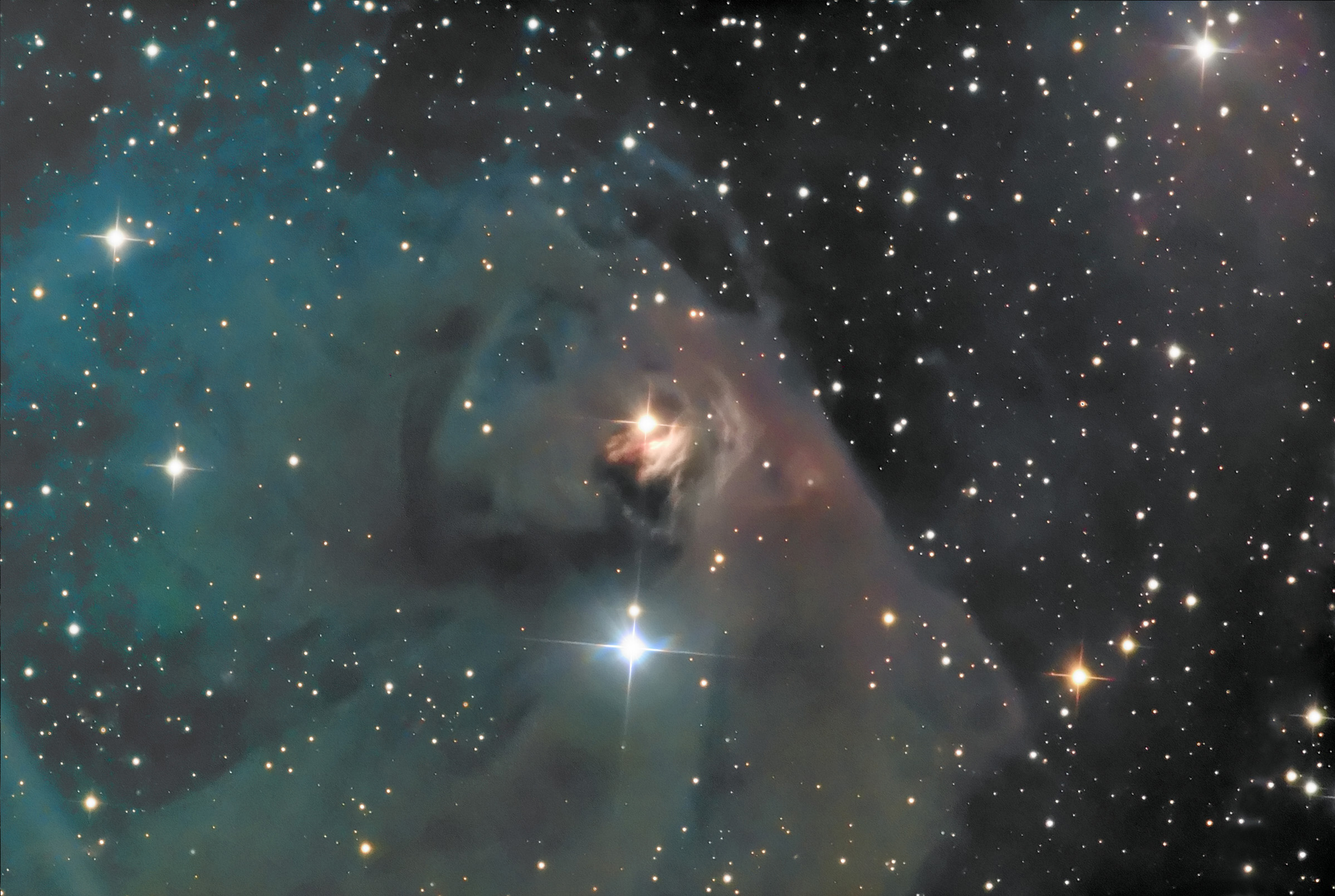 The bright star in the center of the photo is T Tauri. T Tauri is the prototype for the type of stars named after it. These are stars that have recently been revealed from the gasous clouds in which they were formed. They are usually a few million years old, and still in the early stages of development. The large cloud next to T Tauri is known as Hind's Variable Nebula. Hind's Nebula is interesting because it can vary drastically in brightness. The scope of the photo is about 4 lightyears across.
The bright star in the center of the photo is T Tauri. T Tauri is the prototype for the type of stars named after it. These are stars that have recently been revealed from the gasous clouds in which they were formed. They are usually a few million years old, and still in the early stages of development. The large cloud next to T Tauri is known as Hind's Variable Nebula. Hind's Nebula is interesting because it can vary drastically in brightness. The scope of the photo is about 4 lightyears across.Friday, December 7, 2007
2.6 APOD
 This is a spiral galaxy known as M47. It is composed of about 100 billion stars and is located 32 million light-years away from Earth, near the constellation Pisces. The arms of the spiral are made up of dust and gas, as well as blue star clusters. The red sections in the galaxy are star forming regions. The color comes from hydrogen gas. M47 is about 30,000 light-years across, and this photo was constructed from shots taken by the Hubble Space Telescope between 2003 and 2005.
This is a spiral galaxy known as M47. It is composed of about 100 billion stars and is located 32 million light-years away from Earth, near the constellation Pisces. The arms of the spiral are made up of dust and gas, as well as blue star clusters. The red sections in the galaxy are star forming regions. The color comes from hydrogen gas. M47 is about 30,000 light-years across, and this photo was constructed from shots taken by the Hubble Space Telescope between 2003 and 2005.Friday, November 30, 2007
2.5 APOD
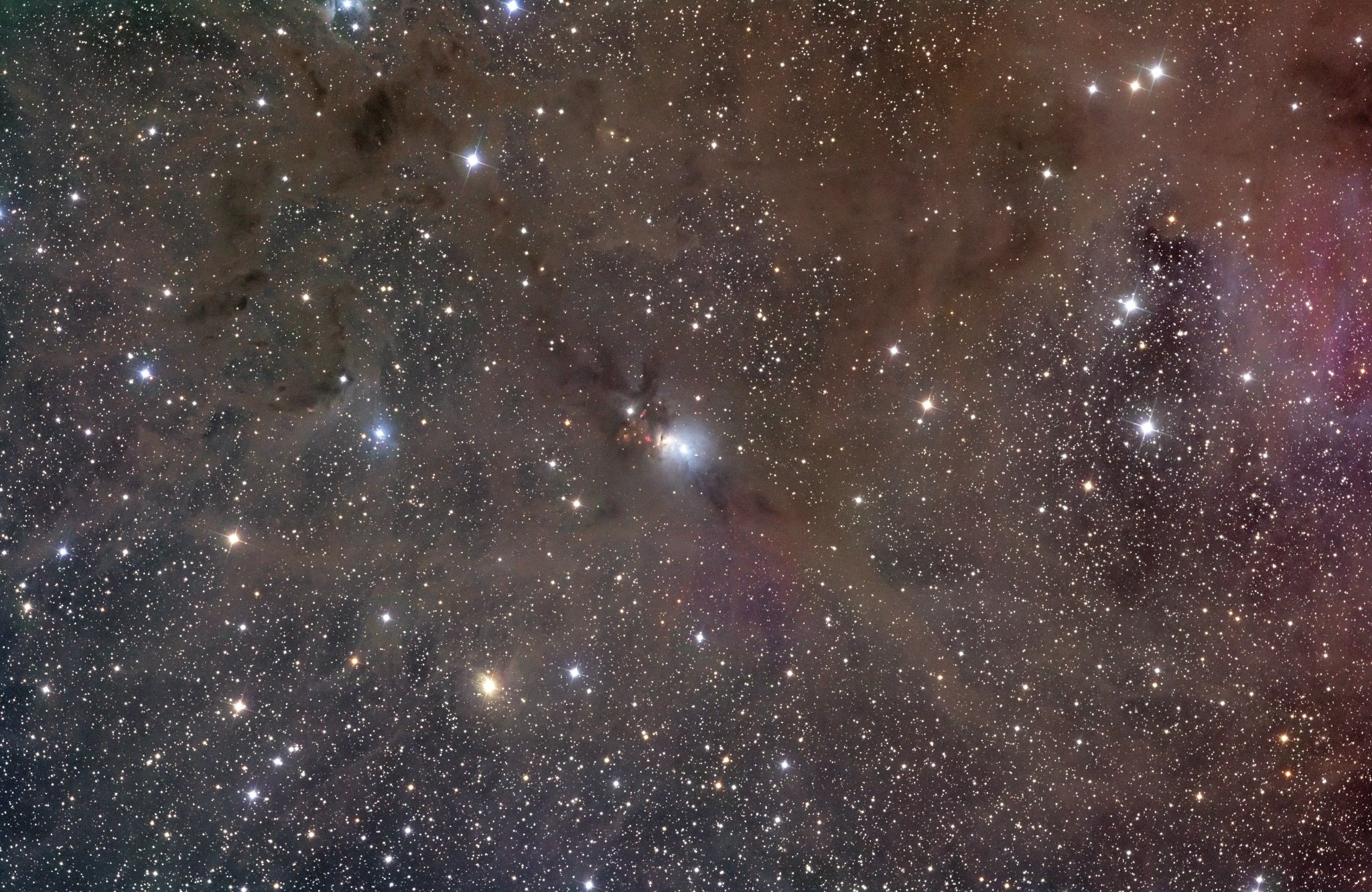 Here in Perseus is a minxture of dust, gas and stars that spans about 4 degrees of the sky. The large bright spot in the center is the object NGC 1333 which is a reflection nebula that has been mapped by radio waves. It is one of the closest star forming regions to Earth, at about
Here in Perseus is a minxture of dust, gas and stars that spans about 4 degrees of the sky. The large bright spot in the center is the object NGC 1333 which is a reflection nebula that has been mapped by radio waves. It is one of the closest star forming regions to Earth, at about1,000 light-years away. The red glow in the picture comes from hydrogen gas, and the region is part of a larger molecular cloud that leads scientists to believe that this is a star forming region. These clouds typically hide young stars. This type of "stellar nursuries" are common.
Friday, November 16, 2007
2.4 APOD
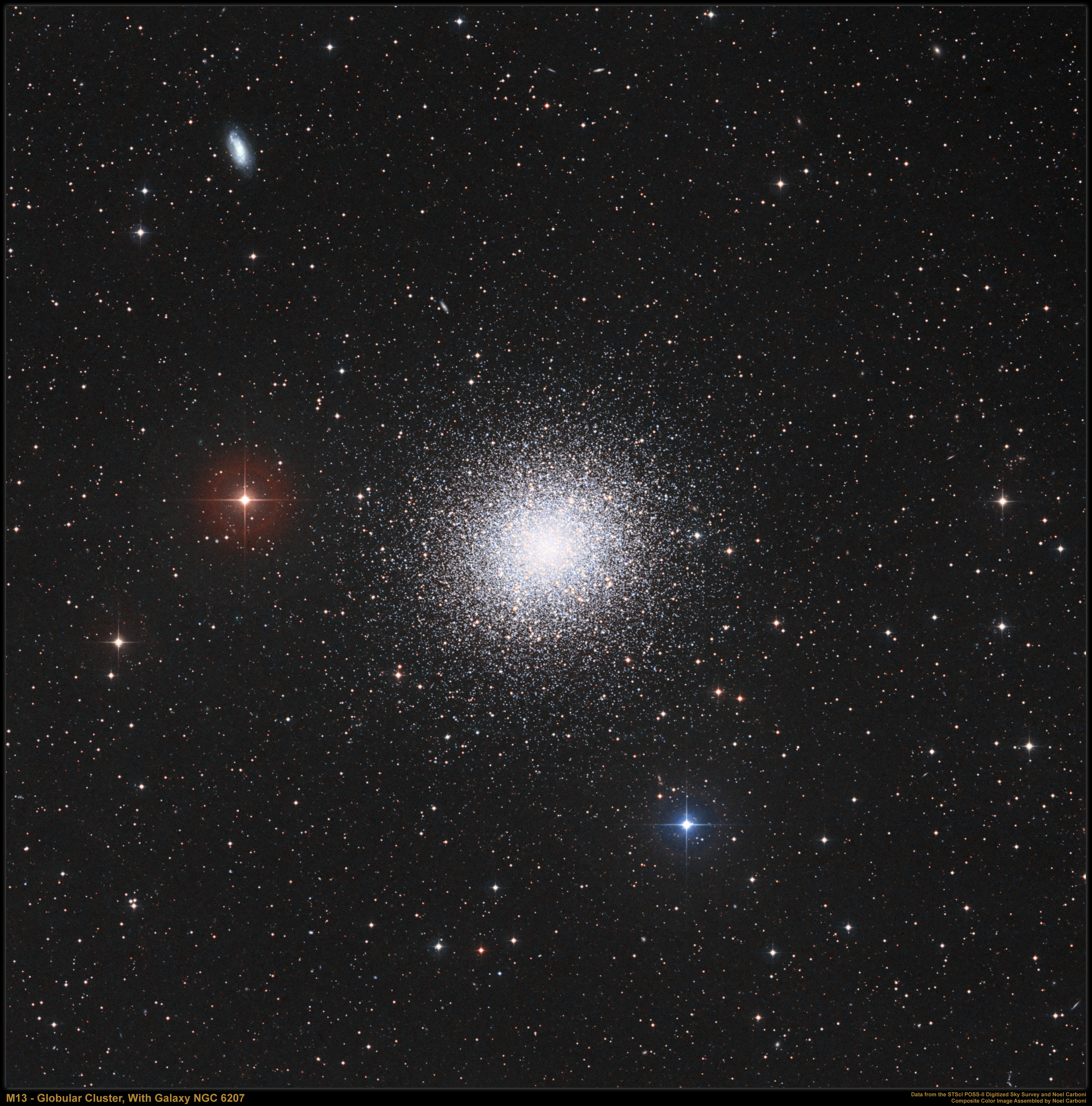 This is a shot of the M13 globular cluster in the constellation Hercules. This cluster is home to hundreds of thousands of stars, making it one of the brightest clusters in the northern sky. The cluster, which is over 25,000 lightyears away, is about 145 lightyears wide. It is widely excpeted that M13 is between 14 and 24 billion years old. Also in the top left of the photo is a galaxy called NGC 6207. M13 was discovered by Sir Edmond Halley in 1714, and is a favorite of amateur astronomers because it so much brighter than most globular clusters.
This is a shot of the M13 globular cluster in the constellation Hercules. This cluster is home to hundreds of thousands of stars, making it one of the brightest clusters in the northern sky. The cluster, which is over 25,000 lightyears away, is about 145 lightyears wide. It is widely excpeted that M13 is between 14 and 24 billion years old. Also in the top left of the photo is a galaxy called NGC 6207. M13 was discovered by Sir Edmond Halley in 1714, and is a favorite of amateur astronomers because it so much brighter than most globular clusters.Monday, November 12, 2007
Observation 2.1
Date: November 5, 2007
Time: 7:00-9:00
Place: Suncoast Community Church (Clark Road east of the Interstate)
Sky conditions: Clear
Instruments used: binoculars, school telescope
Planets: Jupiter (Setting)
Bright Stars: Aldebaran, Altair, Vega, Deneb, Polaris, Fomalhaut
Constellations: Cassiopeia, Cygnus, Cepheus, Taurus, Delphinius, Pisces Austrinus, Lyra, Vulpecula
Binary Stars: Epsilon Lyrea (difficult to distinguish the different colors)
Deep Sky Objects: M45 (Star cluster), M57, M31, M27 (all but M45 mostly looked like fuzzy circles)
Other: Holmes Comet (visible with the naked eye, looked fuzzy, did not yet have a tail)
Time: 7:00-9:00
Place: Suncoast Community Church (Clark Road east of the Interstate)
Sky conditions: Clear
Instruments used: binoculars, school telescope
Planets: Jupiter (Setting)
Bright Stars: Aldebaran, Altair, Vega, Deneb, Polaris, Fomalhaut
Constellations: Cassiopeia, Cygnus, Cepheus, Taurus, Delphinius, Pisces Austrinus, Lyra, Vulpecula
Binary Stars: Epsilon Lyrea (difficult to distinguish the different colors)
Deep Sky Objects: M45 (Star cluster), M57, M31, M27 (all but M45 mostly looked like fuzzy circles)
Other: Holmes Comet (visible with the naked eye, looked fuzzy, did not yet have a tail)
Friday, November 9, 2007
2.3 APOD
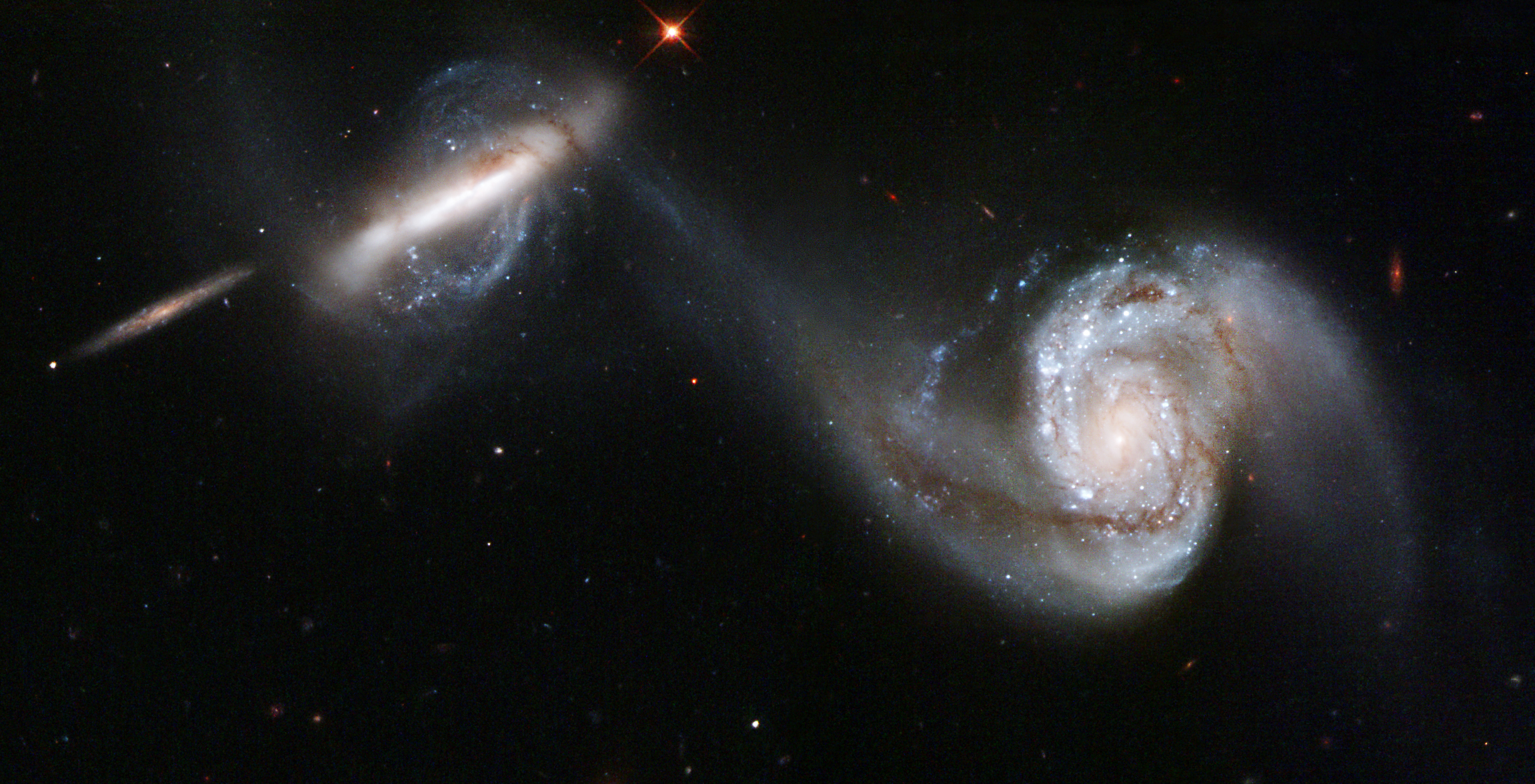 These two galaxies are known collectively as Arp 87. The bridge between them is made of stars, gas, and dust. It spans 75,000 lightyears, and shows that there is a gravitational connection between the two galaxies. At one point, the two galaxies came close to eachother and a "violent gravitational battle" ensued. This type of connection is relatively common, and it is expected that the two galaxies will eventually join to create one larger galaxy. The blue spots on the galaxy on the right are regions where new stars have recently formed. This was likely a result of the interaction between the two galaxies.
These two galaxies are known collectively as Arp 87. The bridge between them is made of stars, gas, and dust. It spans 75,000 lightyears, and shows that there is a gravitational connection between the two galaxies. At one point, the two galaxies came close to eachother and a "violent gravitational battle" ensued. This type of connection is relatively common, and it is expected that the two galaxies will eventually join to create one larger galaxy. The blue spots on the galaxy on the right are regions where new stars have recently formed. This was likely a result of the interaction between the two galaxies.
Friday, November 2, 2007
2.2 APOD
 This picture was taken during a sunset in Sweden. Because sunset rises up, it often appears to be night on the ground and day in the air. This picture is a little different, however, because of the Noctilucent clouds seen in the sky. These Noctilucent clouds, also known as polar mesopheric clouds, are the highest clouds in the Earth's atmosphere. They are often visible in the summer months at places of high latitudes, like Sweden. Not much is known about these clouds, ut it is thought that they are made up of ice particles. Several satellites have been launched to study the objects. Scientists have found clouds similar to the Noctilucent clouds made of carbon dioxide on Mars.
This picture was taken during a sunset in Sweden. Because sunset rises up, it often appears to be night on the ground and day in the air. This picture is a little different, however, because of the Noctilucent clouds seen in the sky. These Noctilucent clouds, also known as polar mesopheric clouds, are the highest clouds in the Earth's atmosphere. They are often visible in the summer months at places of high latitudes, like Sweden. Not much is known about these clouds, ut it is thought that they are made up of ice particles. Several satellites have been launched to study the objects. Scientists have found clouds similar to the Noctilucent clouds made of carbon dioxide on Mars.
Wednesday, October 24, 2007
2.1 APOD
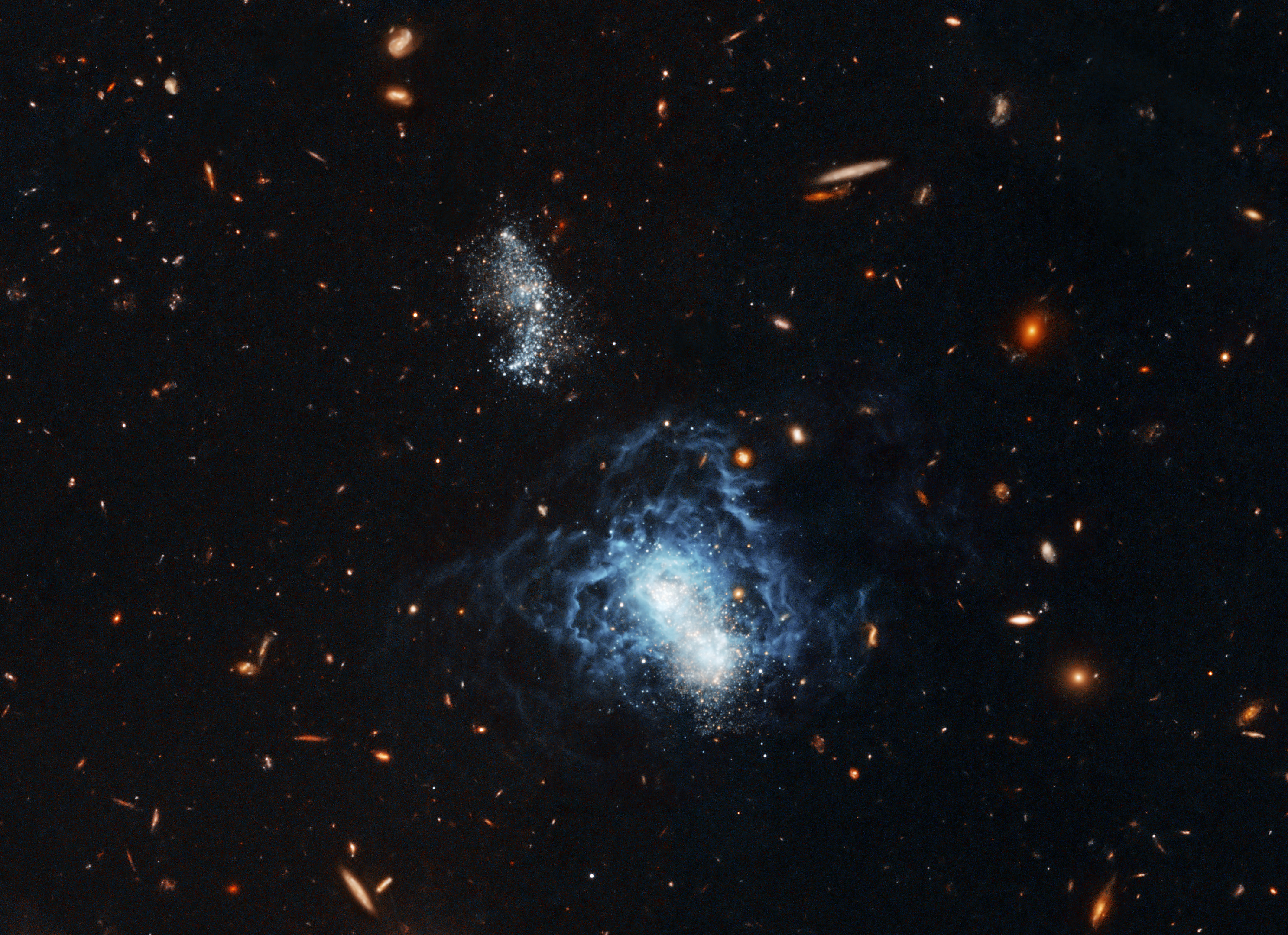 This photograph shows I Zwicky 18, until recently thought to be the youngest known galaxy in space. Some of the stars in it are only about 500 million years old, while the Sun in our solar system is about 4.5 billion years old. The Hubble Space Telescope recently took pictures that revealed that I Zwicky 18 was much older than it appeared. The pictures show that there are older stars mixed in with the bright young stars. Astronomers now believe that I Zwicky 18 is 10 billion years old. Relative to other galaxies its age, I Zwicky 18 forms new stars very frequently, explaining why it was thought to be so young. Another galaxy is visible to the right of I Zwicky 18. Astronomers think that the changes in gravitational pull between the two galaxies may be the reason for the quick star production in I Zwicky 18.
This photograph shows I Zwicky 18, until recently thought to be the youngest known galaxy in space. Some of the stars in it are only about 500 million years old, while the Sun in our solar system is about 4.5 billion years old. The Hubble Space Telescope recently took pictures that revealed that I Zwicky 18 was much older than it appeared. The pictures show that there are older stars mixed in with the bright young stars. Astronomers now believe that I Zwicky 18 is 10 billion years old. Relative to other galaxies its age, I Zwicky 18 forms new stars very frequently, explaining why it was thought to be so young. Another galaxy is visible to the right of I Zwicky 18. Astronomers think that the changes in gravitational pull between the two galaxies may be the reason for the quick star production in I Zwicky 18.
Friday, October 12, 2007
1.7 APOD
 This photo contains an image of NGC 4631, or the "whale galaxy." NGC 4631 is the edge-on spiral galaxy in the top right hand corner of the photo. It is about the same size as our Milky Way. The blurry dot directly above the galaxy is called NGC 4627. The "whale galaxy" is about 30,000 kly away. It is also known as the "herring galaxy" because of it's shape. NGC 4631 has a close relationship with the other major galaxy apparent in the photo, called NGC 4656. Also known as the "hockey stick galaxy," NGC 4656 is connected to NGC 4631 by a thin branch of hydrogen gas. The "hockey stick galaxy is about 25 million ly away from Earth. Evidence shows that all three galaxies have interacted in the past.
This photo contains an image of NGC 4631, or the "whale galaxy." NGC 4631 is the edge-on spiral galaxy in the top right hand corner of the photo. It is about the same size as our Milky Way. The blurry dot directly above the galaxy is called NGC 4627. The "whale galaxy" is about 30,000 kly away. It is also known as the "herring galaxy" because of it's shape. NGC 4631 has a close relationship with the other major galaxy apparent in the photo, called NGC 4656. Also known as the "hockey stick galaxy," NGC 4656 is connected to NGC 4631 by a thin branch of hydrogen gas. The "hockey stick galaxy is about 25 million ly away from Earth. Evidence shows that all three galaxies have interacted in the past.Tuesday, October 9, 2007
Astronomer Project: Tycho Brahe
 Tycho Brahe
Tycho BraheTycho Brahe, born in 1546, was one of the most influential astronomers of all time. His observations had a huge impact on the field of astronomy. Brahe was born in Scania, now part of Sweden, to a noble family. Initially, Brahe attended the University of Copenhagen to study law, but after viewing a solar eclipse in 1560, astronomy became Brahe’s passion.
Brahe is remembered as having a rich personality. This is illustrated by an incident that occurred while he was still a university student. He had an argument with a fellow student who ended up slicing off the bridge of Brahe’s nose. To replace the missing section, Brahe began putting metal pieces there. This sparked his interest in alchemy. Another interesting anecdote from Brahe’s life involved his pet moose. Brahe had a tame moose that was generally very well-behaved. Unfortunately, however, Brahe reported that the moose died after it drank too much beer and fell down the stairs, breaking its leg.
Not only did Brahe have an exuberant personality, but he was also incredibly intelligent and driven. Born nine years prior to the invention of the telescope, Brahe made his observations with the naked eye. He also used tools of his own creation to measure angles in the sky.
Brahe made the most accurate measurements of the positions of planets and stars ever recorded at the time. One reason Brahe’s measurements were so revolutionary was that he followed celestial objects throughout their orbits. His observations led him to believe in a geocentric model of the solar system. Unlike the Ptolemaic model, Brahe thought that the Sun orbited Earth and the other planets orbited the Sun. This model pleased astronomers that felt that the Ptolemaic model was incorrect, and was also more acceptable to the Church who disapproved of the belief that the Earth orbited the Sun. The model was even adopted as the official model of the universe by the Catholic Church. Brahe believed the Earth was still because he never observed parallax, meaning he never saw a shift in relative distance between stars that were close and those that were in the background. While parallax does in fact exist, Brahe was never able to detect it because it requires extremely precise measurements.
Another contribution Brahe made to astronomy was the discovery of a new star in the constellation Cassiopeia. This finding inspired Brahe to publish his first book, titled De Stella Nova, and cemented his role as an influential astronomer. This discovery, as well as the discovery of a comet that he made five years later, was significant because it disproved Aristotle’s belief that the sky was unchanging. The star, currently known as SN 1572, is now known to be a supernova about 7500 light years away.
After hearing of Brahe’s important observations, King Frederick II of Denmark allotted a small island called Hven to Brahe on which he could build an observatory. On the island, Brahe built a castle, called Uraniborg and an observatory called Stjerneborg. Stjerneborg was mostly underground, and it was there that Brahe used the instruments for observation that he built.
One of Brahe’s assistant, Johannes Kepler, would go on to become a noted astronomer in his own right. This was largely a result of the detailed observation logs that Brahe accumulated throughout his career, passing to Kepler after his death. With Brahe’s observations, Kepler made the calculations that led him to his three laws of planetary motion.
Brahe died in Prague, the city that he eventually moved to after a dispute with King Christian IV of Denmark, on October 24, 1601. He was a noted astronomer, alchemist, and astrologer, as well as a memorable character.
Works Cited
Ferguson, Kitty. Tycho and Kepler. New York: Walker & Company, 2002.
"The Astronomer Tycho Brahe." Tychobrahe.Com. 9 Oct. 2007 <http://www.tychobrahe.com/eng_tychobrahe/index.html.>
Van Helden, Al. "Tycho Brahe." 1995. The Galileo Project. 9 Oct. 2007 <http://galileo.rice.edu/sci/brahe.html>.
Monday, October 8, 2007
Observation 1.3
Date: October 7,2007
Time: 10-10:20 PM
Location: Bee Ridge Rd. (East of the interstate)
Sky conditions: mostly clear with just a few clouds
Plantes: Jupiter was low above the horizon
Bright Stars: Antares, Altair, Vega (I couldn't tell which star was Deneb, so I was not able to identify the entire summer triagle)
Constellations noted: Delphinus, Aquila (although it was difficult to see because of the Milky Way)
Other: The moon was a waning cresent, it was barely visible; the Milky Way was also visible (at first I thought it was clouds, but it was such a defined stretch that I eventually realized it was the Milky Way)
Time: 10-10:20 PM
Location: Bee Ridge Rd. (East of the interstate)
Sky conditions: mostly clear with just a few clouds
Plantes: Jupiter was low above the horizon
Bright Stars: Antares, Altair, Vega (I couldn't tell which star was Deneb, so I was not able to identify the entire summer triagle)
Constellations noted: Delphinus, Aquila (although it was difficult to see because of the Milky Way)
Other: The moon was a waning cresent, it was barely visible; the Milky Way was also visible (at first I thought it was clouds, but it was such a defined stretch that I eventually realized it was the Milky Way)
Friday, October 5, 2007
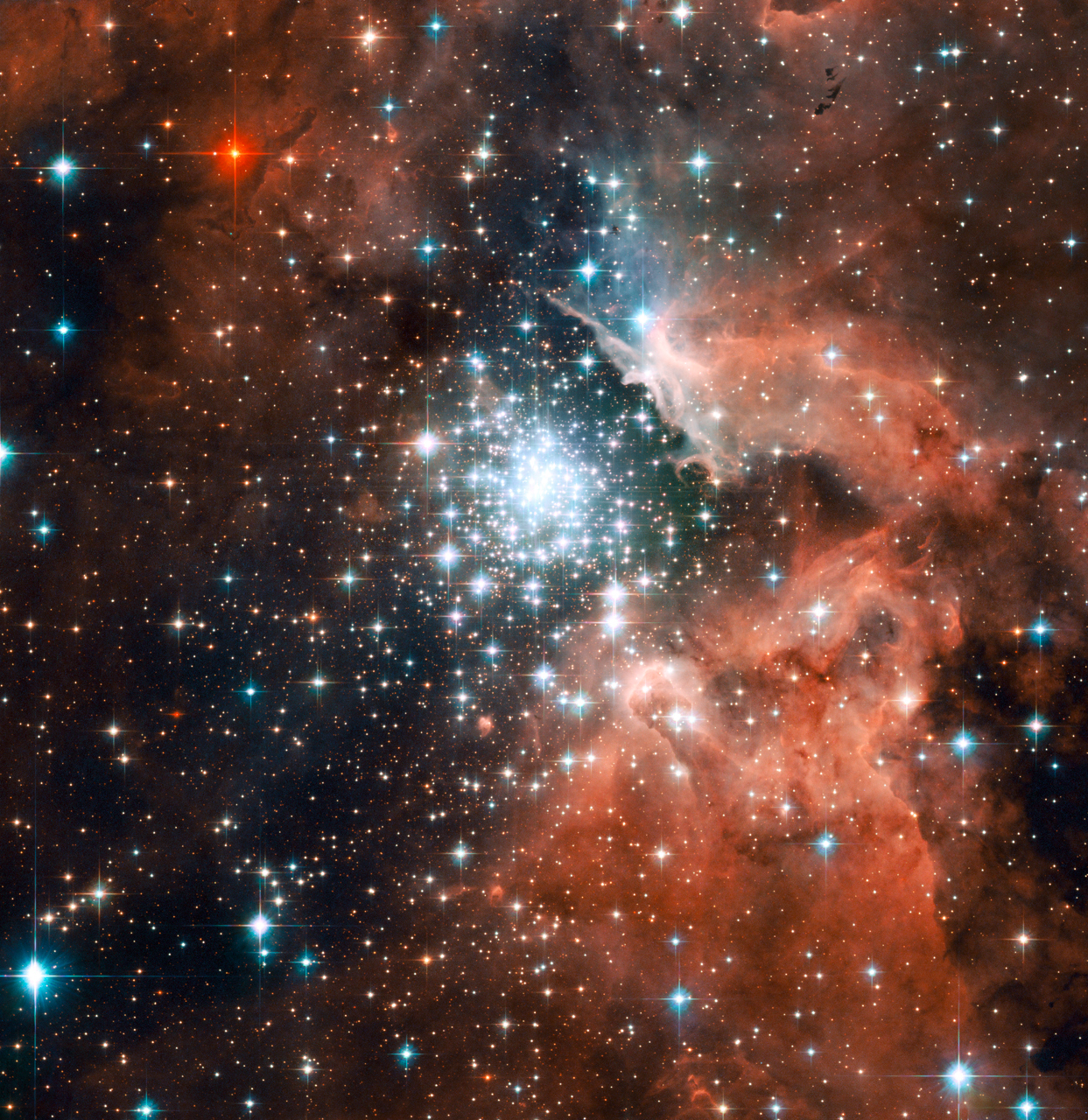 This picture is of NGC 3603, one of the largest star-forming regions in the Milky Way. It is 20,000 lightyears away from the Sun. NGC 3603 contains thousands of stars, many of which are larger than the Sun. The star cluster is about 20 lightyears across, and is close to the constellation, Carina. NGC 3603 is a relatively young star cluster. Some of its stars are only a million years old, while the Sun is about 5 billion years old. This picture was taken by the Hubble Space Telescope.
This picture is of NGC 3603, one of the largest star-forming regions in the Milky Way. It is 20,000 lightyears away from the Sun. NGC 3603 contains thousands of stars, many of which are larger than the Sun. The star cluster is about 20 lightyears across, and is close to the constellation, Carina. NGC 3603 is a relatively young star cluster. Some of its stars are only a million years old, while the Sun is about 5 billion years old. This picture was taken by the Hubble Space Telescope.Friday, September 28, 2007
1.5 APOD
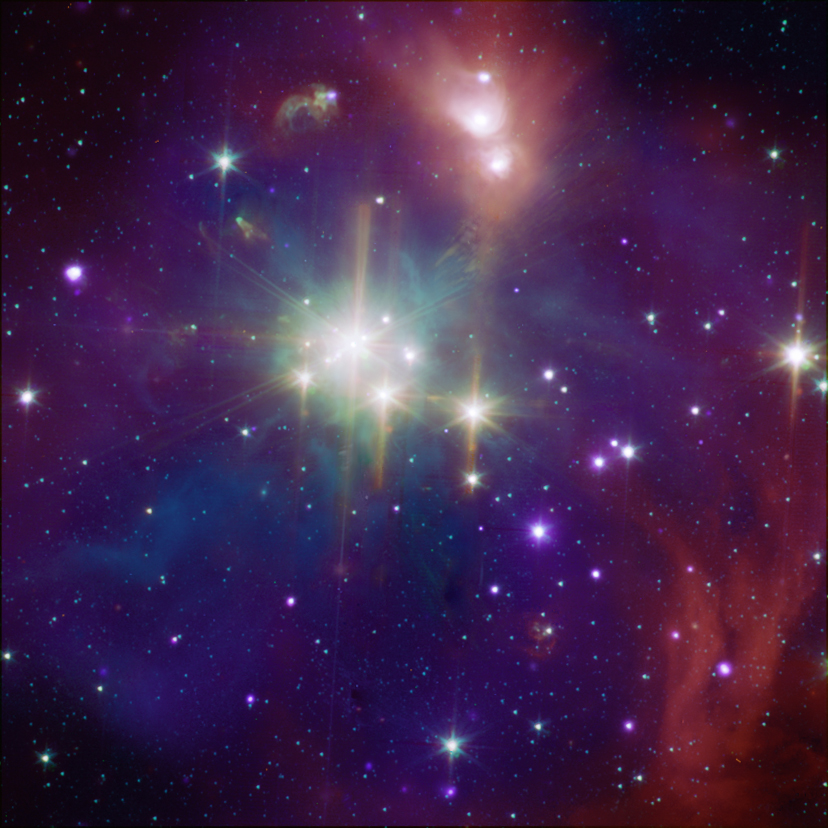 I chose this picture because it is of the Corona Australis, or the Southern Crown, which is one of our constellations of the week. In this picture we see infrared light coming from stars and cosmic dust, as well as x-rays coming from developing young stars. Clearly, this picture is done in false color because neither x-rays nor infrared light is visible. The grouping of bright stars is called the Coronet Cluster and it's interesting because it is made up of stars with very different sizes, as well as different stages of development. This cluster is about 420 light-years away from us, which is a relatively short distance. The image comes from the Chandra orbiting observatory and the Spitzer Space Telescope.
I chose this picture because it is of the Corona Australis, or the Southern Crown, which is one of our constellations of the week. In this picture we see infrared light coming from stars and cosmic dust, as well as x-rays coming from developing young stars. Clearly, this picture is done in false color because neither x-rays nor infrared light is visible. The grouping of bright stars is called the Coronet Cluster and it's interesting because it is made up of stars with very different sizes, as well as different stages of development. This cluster is about 420 light-years away from us, which is a relatively short distance. The image comes from the Chandra orbiting observatory and the Spitzer Space Telescope.
Friday, September 21, 2007
1.4 APOD
This photo was taken in 2003 in North Carolina.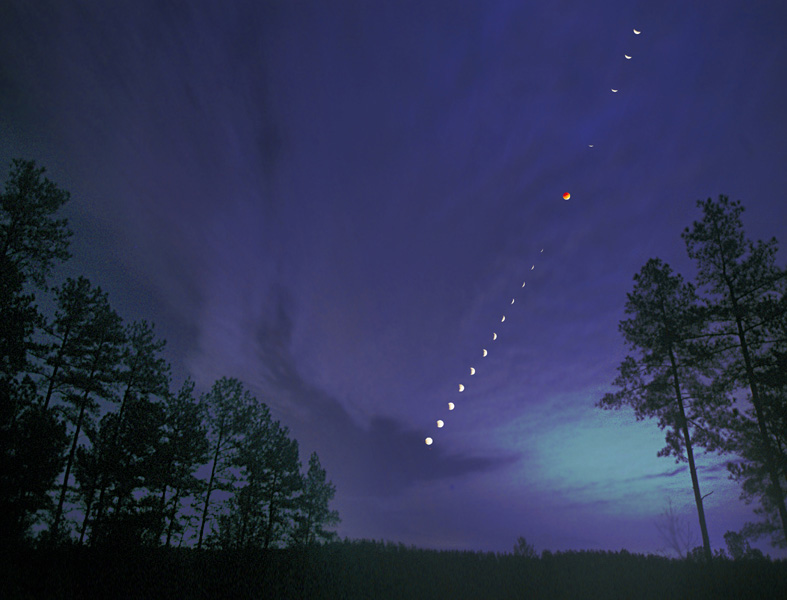 In this photo, the moon will seem to disappear for a couple of days. When this picture was taken, Earth moved between the sun and the moon, making the moon appear very dark, almost invisible. The next time there will be a visible total lunar eclipse is next February.
In this photo, the moon will seem to disappear for a couple of days. When this picture was taken, Earth moved between the sun and the moon, making the moon appear very dark, almost invisible. The next time there will be a visible total lunar eclipse is next February.
 In this photo, the moon will seem to disappear for a couple of days. When this picture was taken, Earth moved between the sun and the moon, making the moon appear very dark, almost invisible. The next time there will be a visible total lunar eclipse is next February.
In this photo, the moon will seem to disappear for a couple of days. When this picture was taken, Earth moved between the sun and the moon, making the moon appear very dark, almost invisible. The next time there will be a visible total lunar eclipse is next February.
1.3 APOD
 This is a volcano called Tungurahua in Ecuador. It is 5,000 meters high. The volcano is currently active, and its last major eruption, which took place on August 16 of last year is seen in this photo. Ash and gases are spewing from the volcano. This volcano is still erupting today, but not violently. The ash that is erupting into the air is made up of jagged peices of rock and glass. The white clouds of steam surrounding the volcano show how hot the volcano is while erupting.
This is a volcano called Tungurahua in Ecuador. It is 5,000 meters high. The volcano is currently active, and its last major eruption, which took place on August 16 of last year is seen in this photo. Ash and gases are spewing from the volcano. This volcano is still erupting today, but not violently. The ash that is erupting into the air is made up of jagged peices of rock and glass. The white clouds of steam surrounding the volcano show how hot the volcano is while erupting.Friday, September 14, 2007
APOD 1.2
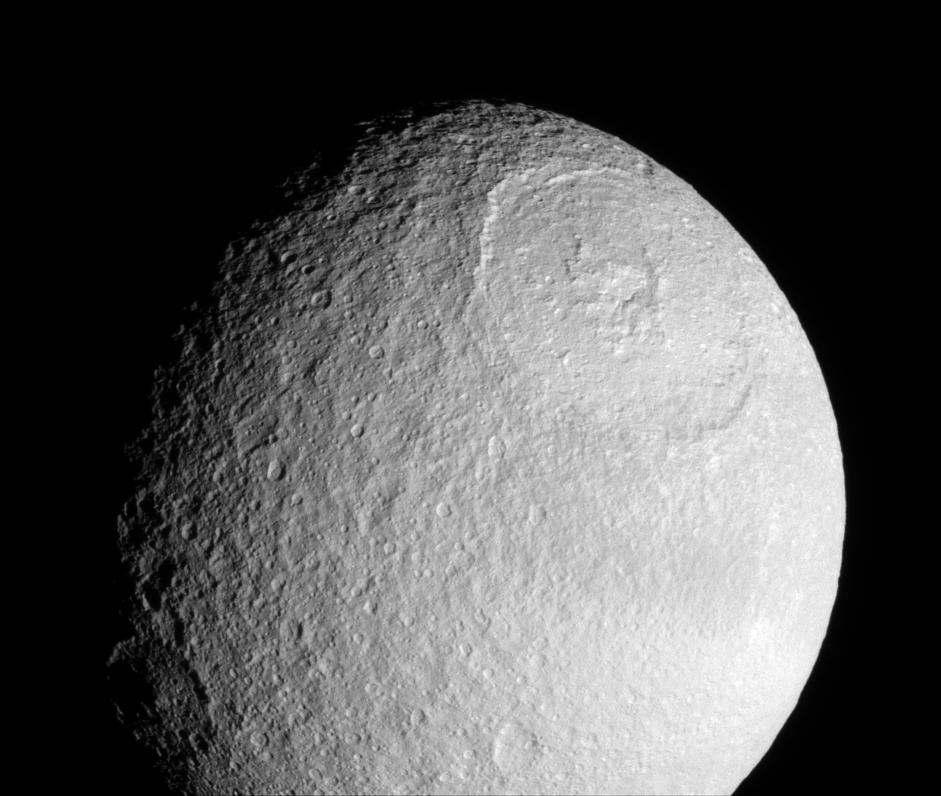 THE GREAT BASIN ON SATURN'S TETHYS
THE GREAT BASIN ON SATURN'S TETHYSThis picture of Saturn's moon, Tethys, is really interesting. The picture was taken by the Cassini Spacecraft while orbiting the moon in July. Tethys is one of Saturn's larger moons with a diameter of about 1000 kilometers. One of the most interesting features revealed by the image is that of Tethys' large basin, Odysseus. Scientists believe that many moons would not survive the imapct from an object large enough to create a crater of that size. The fact that the crater did not shatter on impact shows that the moon is warm and malleable, possible with a liquid center. The crater alone is about 2/5 the size of the moon, or about 400 kilometers in diameter. Tethys is also home to another large crater called Melanthius.
Tuesday, September 11, 2007
Observation 1.2
Date: September 7, 2007
Time: 8:50-9:10
Place: Bee Ridge (East of the interstate)
Sky conditions: Clear skies
Planets: Jupiter was visible.
Bright Stars: The only stars that I could identify were Polaris and Antares, Scorpius was in the sky.
Other: Iridium 70 was visible due North. It was very bright to begin with (-7 Magnitude to begin with). It faded and was no longer visible at about 15 degrees above the horizon.
It was a very clear night and there were lots of stars. The moon was a waning crescent, and it was not visible.
Time: 8:50-9:10
Place: Bee Ridge (East of the interstate)
Sky conditions: Clear skies
Planets: Jupiter was visible.
Bright Stars: The only stars that I could identify were Polaris and Antares, Scorpius was in the sky.
Other: Iridium 70 was visible due North. It was very bright to begin with (-7 Magnitude to begin with). It faded and was no longer visible at about 15 degrees above the horizon.
It was a very clear night and there were lots of stars. The moon was a waning crescent, and it was not visible.
Observation 1.1
Date: August 22, 2007
Time: 9:40-10:00
Place: Bee Ridge (East of the interstate)
Conditions: Clear sky
Planets: The only one I could identify was Jupiter which was about 6 degrees away from the moon.
Stars: Antares was about 3 degrees South of Jupiter.
Other: I also did some observations on 8/21 and found that the moon shifted South from that date. Scorpius is in the sky, but I could not find the entire constellation.
Time: 9:40-10:00
Place: Bee Ridge (East of the interstate)
Conditions: Clear sky
Planets: The only one I could identify was Jupiter which was about 6 degrees away from the moon.
Stars: Antares was about 3 degrees South of Jupiter.
Other: I also did some observations on 8/21 and found that the moon shifted South from that date. Scorpius is in the sky, but I could not find the entire constellation.
Friday, September 7, 2007
APOD 1.1
 TIME TUNNEL
TIME TUNNELThis photograph is really amazing. It's interesting because it allows you to see both stars and galaxies. The closest stars are the skipey looking ones, while the galaxies are the fuzzy looking objects. It's impressive that it was taken by an amature astronomer. There is even a quasar in the photo that is 12.7 billion light years away. Quasars are among the most distant mesuarble objects. They are interesting because they emit huge amounts of energy but it's debated where the energy comes from. Some astronomers believe that the energy comes from a giant black hole that feeds on gas, dust, and other stars.
Subscribe to:
Posts (Atom)